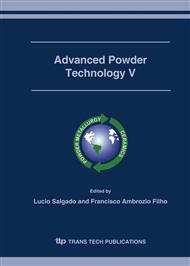p.3
p.10
p.16
p.22
p.29
p.35
p.41
p.48
p.53
Study of the Recycling Grey Cast Iron Swarf by Powder Metallurgy: An Alternative for the Development of New Materials
Abstract:
This work is concerned with issues related to using grey cast iron swarf from dry machining in powder metallurgy. In a first stage, a complete study on the characteristics of the raw powder is performed, in which aspects related to the dilution in different proportion of pure iron were studied. Low compacting pressure produces workpieces more resistant and that the ideal sintering temperature is 1160 °C. In a second stage, aiming at reduction of the powder, a heat treatment is performed. New dilutions using the decarburized powder were made and results showed better structural homogeneity and an improvement in the mechanical properties. The steel alloy 50/50% of swarf powder provided the best results. In a third stage, a cylindrical bearing was produced. New dilutions were made. Based on the control of the interconnected porosity, radial and wear resistance, the sample prepared with 100% swarf powder provided the best results.
Info:
Periodical:
Pages:
3-9
Citation:
Online since:
November 2006
Authors:
Keywords:
Price:
Сopyright:
© 2006 Trans Tech Publications Ltd. All Rights Reserved
Share:
Citation:


